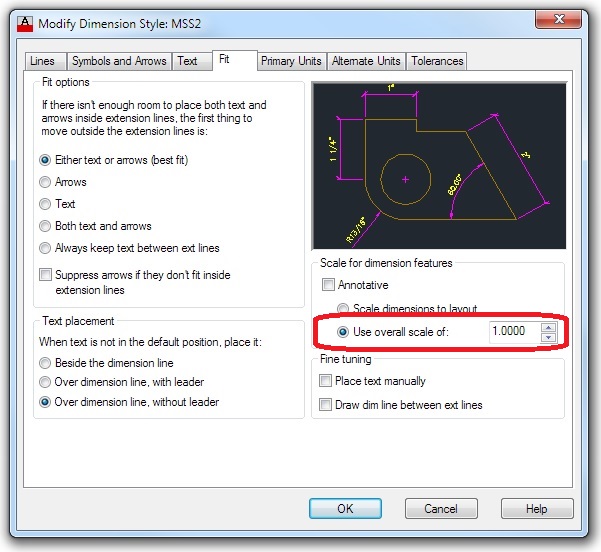How To Change Dimension Text Size In Autocad 2017
Tip 1038

This article was selected for publication in CAD Digest
Text in AutoCAD dimensions can be puzzling. This post will cover some basic concepts and 2 different approaches to controlling the size of text in dimensions. Allow's commencement with some general guidelines:
Editing individual dimension objects
Text can be re-formatted or adjusted for an individual dimension object by selecting the object then using the Properties dialog box. The Text section of the Properties dialog box is shown beneath. Changes fabricated here accept no issue on other dimension objects, and no outcome on the dimension style. Information technology'due south just a 1-shot modification.

The Text section of the Properties box
Formatting dimension text using the Dimension Manner Editor
On the other hand, text format changes made in the Dimension Style Editor affect all of the dimensions having that style. The change will bear on existing dimension objects in your drawing, besides equally future dimension objects created using that style. Hither is a sample of the Text tab in the Dimension Style Editor.

The Text tab in the Dimension Style editor
It's a good thought to use a text fashion having an assigned pinnacle of zero (0) for the dimension text. This volition brand the dimension text change its height to match the electric current DIMSCALE setting when a new dimension object is created.
That's why the text manner in the in a higher place image is called "SIMPLEXZERO". That's a text style I created for dimensions, using the Simplex font set to accept a height of zippo in the Text Manner Editor.
If the text mode height was set to a not-zero number, say ix inches, the dimension text would maintain that exact pinnacle in model space regardless of the DIMSCALE setting. This would not let dimensions to automatically self-adjust for dissimilar drawing scales.
The One-DIMSTYLE-Fits-All Approach
In the paradigm above, y'all'll observe that the Text height is set in the Dimension Style Editor at iii/32″. This means that the text will automatically arrange itself to impress on paper at exactly 3/32″ high when the electric current DIMSCALE is set to match the calibration gene of the current cartoon. For example, you would use a DIMSCALE of 96 for a 1/8″=i′-0″ scale drawing.
I gear up the electric current DIMSCALE by simply typing that command in the command line then typing in the number I desire for the current drawing task. When I get-go piece of work on a particular or view at a different calibration, I change the DIMSCALE again.
This allows the text in multiple views having dissimilar scales to match perfectly in the final printed sail.
By the style, a dimension object, one time created, retains the DIMSCALE that was current at the time it was created. You can see its DIMSCALE, and alter it, by selecting the object and looking in the Properties box under the "Fit" category. The holding item is called "Dim scale overall."
I personally recommend this strategy. Nonetheless, information technology's not the merely i worth because.
The One-DIMSTYLE-Per-Scale Strategy
Some designers or firms utilise a different arroyo to sizing text (and tick marks or arrowheads) in dimensions. They create a separate dimension way for each scale of drawing or view that might be used. This is why y'all might run across dimension styles named "Scale-96″ for use in 1/8" scale drawings, or "SCALE-24″ for use in 1/2″=ane′-0" calibration drawings.
In this strategy, you create one dimension manner you similar, then copy information technology a number of times, with dissimilar settings for the "Use overall calibration of" field in the Dimension Styles > Fit tab, equally shown beneath:

The Fit tab in the Dimension Style Editor
The value of one shown in the prototype above would exist inverse to 96 in the SCALE-96 dimension style for 1/8″ drawings, for example, and you would echo and conform for each calibration needed.
When you become to the Dimension Style Selector in the ribbon and choose, for case, the Calibration-96 dimension style, AutoCAD automatically resets the current DIMSCALE to equal 96.
Personally, I think at that place are advantages and disadvantages to this approach.
The main advantage is that it is "piece of cake-to-use," in the sense that the CAD operator does not accept to think about adjusting the DIMSCALE setting to match the calibration of the current drawing or view.
Nether disadvantages, I would listing ii:
- Information technology requires a big number of dimension styles, which clutter upwardly the drawing file and the DIMSTYLE listing. This issue is multiplied if you maintain more than i dimension style for various types of work, such equally an arrowhead fashion for site program work, architectural tick marks for floor plans and such, and possibly an inch-and-fraction dimension style for cabinetry drawings.
- If you always want (or need) to brand a change to your dimension style, you have to brand the adjustment lots of times, which is an invitation for accidental discrepancies.
- It seems inelegant.
Delight let me know your thoughts. I hope this helps to clarify some of the unlike options.
I hope you'll sign upwardly to receive time to come updates in the form below.
Keep on CADDing! 🙂
Mark

(Visited eleven,725 times, 1 visits today)
Source: https://bestcadtips.com/sizing-text-in-cad-dimensions/
Posted by: davishatted.blogspot.com


0 Response to "How To Change Dimension Text Size In Autocad 2017"
Post a Comment